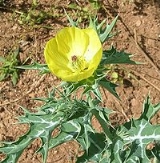
Argemone
Encyclopedia
Argemone is a genus of flowering plant
s in the family
Papaveraceae
. It contains 30 to 32 species, commonly known as prickly poppies, that are native to the Americas
and Hawaii
. The generic name originated as αργεμωνη in Greek
and was applied by Dioscorides
to a poppy-like plant used to treat cataract
s.
Flowering plant
The flowering plants , also known as Angiospermae or Magnoliophyta, are the most diverse group of land plants. Angiosperms are seed-producing plants like the gymnosperms and can be distinguished from the gymnosperms by a series of synapomorphies...
s in the family
Family (biology)
In biological classification, family is* a taxonomic rank. Other well-known ranks are life, domain, kingdom, phylum, class, order, genus, and species, with family fitting between order and genus. As for the other well-known ranks, there is the option of an immediately lower rank, indicated by the...
Papaveraceae
Papaveraceae
Papaveraceae, informally known as the poppy family, are an economically important family of 44 genera and approximately 770 species of flowering plants in the order Ranunculales. The family is cosmopolitan, occurring in temperate and subtropical climates, but almost unknown in the tropics...
. It contains 30 to 32 species, commonly known as prickly poppies, that are native to the Americas
Americas
The Americas, or America , are lands in the Western hemisphere, also known as the New World. In English, the plural form the Americas is often used to refer to the landmasses of North America and South America with their associated islands and regions, while the singular form America is primarily...
and Hawaii
Hawaii
Hawaii is the newest of the 50 U.S. states , and is the only U.S. state made up entirely of islands. It is the northernmost island group in Polynesia, occupying most of an archipelago in the central Pacific Ocean, southwest of the continental United States, southeast of Japan, and northeast of...
. The generic name originated as αργεμωνη in Greek
Greek language
Greek is an independent branch of the Indo-European family of languages. Native to the southern Balkans, it has the longest documented history of any Indo-European language, spanning 34 centuries of written records. Its writing system has been the Greek alphabet for the majority of its history;...
and was applied by Dioscorides
Pedanius Dioscorides
Pedanius Dioscorides was a Greek physician, pharmacologist and botanist, the author of a 5-volume encyclopedia about herbal medicine and related medicinal substances , that was widely read for more than 1,500 years.-Life:...
to a poppy-like plant used to treat cataract
Cataract
A cataract is a clouding that develops in the crystalline lens of the eye or in its envelope, varying in degree from slight to complete opacity and obstructing the passage of light...
s.
Selected species
|
Asa Gray -References:*Asa Gray. Dictionary of American Biography. American Council of Learned Societies, 1928–1936.*Asa Gray. Encyclopedia of World Biography, 2nd ed. 17 Vols. Gale Research, 1998.*Asa Gray. Plant Sciences. 4 vols. Macmillan Reference USA, 2001.... – Rough Prickly Poppy Argemone mexicana Argemone mexicana is a species of poppy found in Mexico and now widely naturalized in the United States, India and Ethiopia... L. – Mexican Prickly Poppy Argemone munita Argemone munita is a species of prickly poppy known by the common names flatbud prickly poppy and chicalote. This flower is native to California, where it is widespread throughout the western part of the state and its eastern deserts. Its range also extends into Baja California. This poppy bears... Durand & Hilg. – Flat-bud Prickly Poppy Argemone pleiacantha Argemone pleiacantha is a species of flowering plant in the poppy family known by the common name southwestern prickly poppy. It is native to Arizona and New Mexico in the United States and Chihuahua, and Sonora in Mexico, where it occurs in dry woodlands and slopes of foothills and mountains. It... Greene – Southwestern Prickly Poppy
|
Formerly placed here
- Papaver armeniacum (L.) DC. (as A. armeniaca L.)

